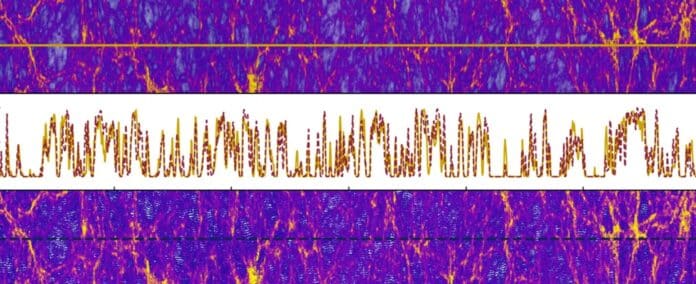Distant quasars are massive objects in space that give off light. This light they produce is the brightest in the whole universe. Looking at this light helps us learn how the universe is organized on a big scale—like 20 million light-years or even more. This is because the light travels through gigantic clouds of neutral hydrogen gas that formed shortly after the Big Bang. So, by studying the light from these quasars, scientists can uncover secrets about the huge structure of the universe.
The National Science Foundation-funded Frontera supercomputer at the Texas Advanced Computing Center helped a scientist named Simeon Bird from UC Riverside. They used information from the light of faraway quasars (really bright things in space) to make an extensive set of computer simulations called PRIYA. These simulations try to copy how the universe is put together on a large scale.
PRIYA uses optical light data from the Extended Baryon Oscillation Spectroscopic Survey, or eBOSS, of the Sloan Digital Sky Survey.
Bird explained, “You compare eBOSS data to a variety of simulation models with different cosmological parameters and different initial conditions to the universe, such as different matter densities. You find the best model and how far from it you can deviate without breaking the reasonable agreement between the data and simulations. This knowledge tells you how much matter and structure there is in the universe.”
PRIYA, an extensive set of computer simulations, is linked to another simulation called ASTRID, made by Simeon Bird. ASTRID helps us understand how galaxies form, how supermassive black holes come together, and how the universe was re-ionized.
PRIYA now takes information about galaxies and the rules for making black holes from ASTRID, but it goes further. It tweaks the initial conditions. Scientists use these changes to take a model that matches galaxies and black holes, change the initial conditions, and then compare it to Lyman-𝛼 forest data from eBOSS of the neutral hydrogen gas.
Bird said, “We made a new analysis with simulations that were much larger and better designed than before. The earlier discrepancies with the Planck CMB data disappeared and were replaced with another tension, similar to what is seen in other low redshift large-scale structure measurements.”
“The study’s main result is to confirm the σ8 tension between CMB measurements and weak lensing exists out to redshift 2, ten billion years ago.”
In simple terms, the PRIYA study helped figure out two important things. One is σ8, which tells us about the amount of neutral hydrogen gas structures in the space of 8 megaparsecs (that’s about 2.6 million light-years). This gives us an idea of how many clumps of dark matter are out there.
The second thing is ns, the scalar spectral index. This is linked to how clumpy dark matter is in different-sized areas. It helps us understand how fast the universe expanded after the Big Bang. So, by studying these two things, scientists get a better picture of the makeup and early history of the universe.
Bird said, “The scalar spectral index initially sets up how the universe behaves. The whole idea of PRIYA is to work out the initial conditions of the universe and how the high energy physics of the universe behaves.”
“The memory requirements for PRIYA simulations are so big you cannot put them on anything other than a supercomputer.”
The PRIYA simulations done on the Frontera supercomputer are huge. It took over 100,000 hours of computing power to simulate a system with about 29 billion particles in a ‘box’ 120 megaparsecs on edge, or about 3.91 million light-years across.
The PRIYA project used over 600,000 computing nodes on Frontera to make these simulations happen. That’s a lot of computational power and time to study and understand the universe’s large-scale structure.
Journal Reference:
- Simeon Bird, Martin Fernandez, Ming-Feng Ho et al. PRIYA: a new suite of Lyman-α forest simulations for cosmology. Journal of Cosmology and Astroparticle Physics. DOI 10.1088/1475-7516/2023/10/037
